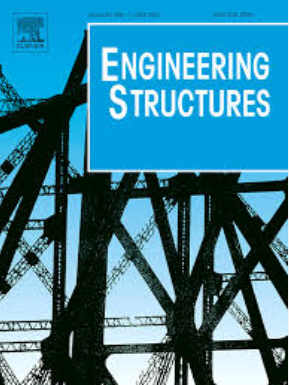填充陶瓷颗粒的纤维增强复合材料缠绕管的船舶碰撞性能
IF 5.6
1区 工程技术
Q1 ENGINEERING, CIVIL
引用次数: 0
摘要
近年来,国内外发生的船舶与桥梁碰撞事故造成了重大人员伤亡和经济损失。为了在此类事故中更好地保护桥梁和船舶,本文提出了一种由填充陶粒的纤维增强复合缠绕管(FCMWTC)组成的新型防撞装置。该结构由纤维增强复合缠绕管外层和填充低密度消能陶瓷颗粒的内层组成。FCMWTC 单元连接在一起,并放置在桥墩周围,以抵御船舶碰撞,为船舶和桥梁提供双重保护。对填充和未填充陶瓷颗粒的不同纤维缠绕角的复合管进行了静态压缩和水平冲击试验。对试样的能量吸收特性和破坏机制进行了分析。使用 ANSYS/LS-DYNA 对水平冲击试验进行了数值模拟,模拟结果与实验数据吻合良好。在验证有限元模型的基础上,进一步比较和分析了纤维缠绕角对冲击力峰值的影响。结果表明,纤维缠绕角为 45° 的复合缠绕管对冲击力的降低率最高,因此是最佳缠绕角。此外,全尺寸船舶-FCMWTC-桥梁碰撞的数值模拟结果表明,该装置具有优异的消能性能,是一种有效的防撞系统。本文章由计算机程序翻译,如有差异,请以英文原文为准。
Ship collision performance of a fiber-reinforced composite material winding tube filled with ceramic pellets
In recent years, collisions between ships and bridges, both domestically and internationally, have led to significant casualties and economic losses. To better protect both bridges and ships during such incidents, this article proposes a new anti-collision device composed of fiber-reinforced composite winding tubes filled with ceramic pellets (FCMWTC). The structure consists of an outer layer made of a fiber-reinforced composite winding tube, with the inner part filled with low-density, energy-dissipating ceramic pellets. The FCMWTC units are connected and positioned around the bridge pier to resist ship collisions, providing dual protection for both ships and bridges. Static compression and horizontal impact tests were conducted on composite tubes with different fiber winding angles, both with and without ceramic pellets filling. The energy absorption characteristics and failure mechanisms of the specimens were analyzed. Numerical simulations of the horizontal impact tests were carried out using ANSYS/LS-DYNA, and the simulation results showed good agreement with the experimental data. Based on the validated finite element model, the influence of fiber winding angle on the peak impact force was further compared and analyzed. The results indicated that the composite winding tube with a 45° fiber winding angle provided the highest reduction rate of impact force, making it the optimal winding angle. In addition, the numerical simulation results of the full-scale ship-FCMWTC-bridge collision demonstrate that the device exhibits excellent energy dissipation performance, making it an effective anti-collision system.
求助全文
通过发布文献求助,成功后即可免费获取论文全文。
去求助
来源期刊

Engineering Structures
工程技术-工程:土木
CiteScore
10.20
自引率
14.50%
发文量
1385
审稿时长
67 days
期刊介绍:
Engineering Structures provides a forum for a broad blend of scientific and technical papers to reflect the evolving needs of the structural engineering and structural mechanics communities. Particularly welcome are contributions dealing with applications of structural engineering and mechanics principles in all areas of technology. The journal aspires to a broad and integrated coverage of the effects of dynamic loadings and of the modelling techniques whereby the structural response to these loadings may be computed.
The scope of Engineering Structures encompasses, but is not restricted to, the following areas: infrastructure engineering; earthquake engineering; structure-fluid-soil interaction; wind engineering; fire engineering; blast engineering; structural reliability/stability; life assessment/integrity; structural health monitoring; multi-hazard engineering; structural dynamics; optimization; expert systems; experimental modelling; performance-based design; multiscale analysis; value engineering.
Topics of interest include: tall buildings; innovative structures; environmentally responsive structures; bridges; stadiums; commercial and public buildings; transmission towers; television and telecommunication masts; foldable structures; cooling towers; plates and shells; suspension structures; protective structures; smart structures; nuclear reactors; dams; pressure vessels; pipelines; tunnels.
Engineering Structures also publishes review articles, short communications and discussions, book reviews, and a diary on international events related to any aspect of structural engineering.
 求助内容:
求助内容: 应助结果提醒方式:
应助结果提醒方式:


